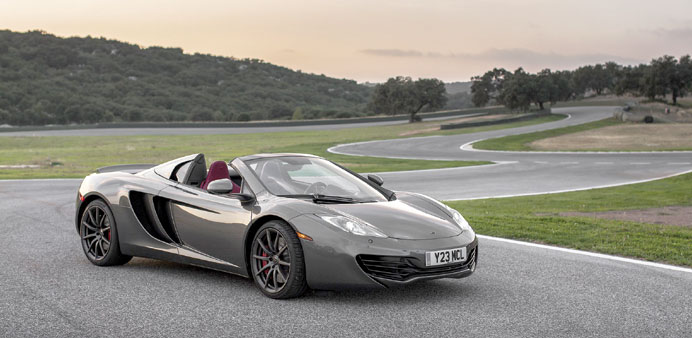By Susan Carpenter
The only missing element was the Houston countdown as I pressed the launch button on the McLaren 12C Spider. Left foot planted on the brake pedal, right foot goosing the gas, the twin-turbocharged V-8 spooled for my imminent catapult across the asphalt.
Six seconds and 200 yards later, I felt lighter, having expelled all the available air in my lungs through an irrepressibly giddy scream. The fact that I was doing this in a convertible speaks volumes for McLaren engineering and its Formula 1 racing legacy.
Being on a track, I was, of course, driving with the roof locked in place and a helmet strapped to my noggin. But the Spider, which was designed in parallel with McLaren Automotive’s fixed-roof 12C coupe, comes with almost no performance penalty. The 0-to-62-mph acceleration time is the same, lickety-split 3.1 seconds. The convertible gained 88 pounds, but just 3 mph were sheared off the 207 mph maximum speed of the hardtop.
The greatest penalty, in fact, is the price (in the US). The Spider costs about $30,000 more than the $231,400 coupe — but that’s pennies for McLaren’s rarefied buyership.
Designed as a track car that’s civilised enough for the street and, now, versatile enough to allow tanning at mach speed, the 12C Spider has been available in the US since January.
Still, the British supercar maker, which produces just 1,800 units annually, hasn’t had enough cars to satisfy the West Coast automotive media’s relentless need for speed until last week, when it cordoned off the asphalt at Auto Club Speedway in Fontana, California — a suitable environment to showcase its streetable F1 technology.
Entering the two-seater 12C Spider through its dihedral doors requires a gymnastic level of limberness to avoid impalement from the sharp angle of the steeply raked windshield, which, once you’re settled in the low-slung and cocooning cockpit, offers great visibility. Visible over the ultra-low dashboard are two distinct humps on either side of the bonnet that orient the driver to the wheels.
The 12C Spider is constructed with the same carbon fiber MonoCell its sister company, McLaren Racing, has been using in Formula 1 since 1981.
Isolated by an aluminum crush structure, should the driver crash, the moulded carbon cockpit is lightweight, strong and rigid for high-speed flogging — and muscular enough that it negates the need for the usual chassis reinforcements required when jettisoning a fixed roof for a spider variant.
It takes 17 seconds for the electronically operated retractable hardtop to fully lift or lower into a tonneau cover whose colour is matched to the body, which, on my test car, was a shade of orange so fiery it looked combustible. The roof can be operated at speeds up to 19 mph. In other words, it’s best done when stopped, so drivers can take full advantage of the 12C Spider’s capabilities.
The Spider is, like the 12C coupe, powered with the upgraded 625PS, or 616-horsepower, engine first deployed for the 2013 model year. Encased in glass like the high-performance art piece it is, the engine — which uses a pair of small, quick-spinning turbochargers to nullify discernible turbo lag and provide more boost at lower revs — can be operated in normal, sport and track modes. They activate different shift points on the seven-speed, dual-clutch transmission when driven as an automatic, and channel increasingly deafening levels of engine intake noise to the cabin.
The only part of the powertrain that was changed for the Spider is the exhaust. Redesigned to work in harmony with the silhouette of the retractable roof, it evacuates up and over the rear axle to avoid coming through the rear suspension. The suspension is likewise adjustable in normal, sport and track modes, independent of the powertrain settings.
It was in track mode that I spun out during my sashay of a fast chicane and started drifting toward a concrete wall at 100 mph, having lifted my foot from the accelerator with the steering wheel cranked from a turn. In sport suspension mode, the car would have intervened and kept my rear wheels planted, but in track mode you’re on your own.
Unique to McLaren, this second suspension-mode panel operates hydraulically interlinked dampers that increase or reduce pressure as needed to affect the stiffness of the suspension and negate the need for sway bars. A Z bar on the rear end acts like a spring, working with the air brake to keep the back axle in better contact with the road and distribute brake force most effectively.
As I careened through corner after corner in the 12C Spider, the air brake was truly something to behold during the occasional split seconds I was able to take my eyes off the track and glance in the rear view mirror. Stomping the brake pedal at speeds above 62 mph instantly activates the F1-derived rear wing that ordinarily nestles in the car’s hindquarters and only glides into place to quicken slowdowns and to keep the car’s rear end from lifting.
For street driving, the rear window can likewise move up and down, regardless of the roof’s position. With the roof lowered, the rear glass automatically finds the most aerodynamic position to reduce buffeting. The audio controls also automatically adjust to compensate for extra noise when the roof is stowed, while the climate control fan is calibrated to the vehicle’s speed.
For 2014, the 12C’s in-cabin technology has been upgraded with a centre console swipe screen that is vertically oriented, similar to a smartphone. It can be operated by touch or with a voice-recognition system similar to the iPhone’s Siri, only McLaren’s personal assistant is known as Iris, and the voice is male.
Driving the 12C Spider on the street, Iris occasionally scolded: “You are over the speed limit.”
Buyers of the McLaren 12C Spider are likely to hear that often. — The Orange County Register/MCT
* Price and technical specifications may vary in locally available models.
In a nutshell
Base price: $265,750 (in the US)
Powertrain: Direct-injected, twin-turbocharged, 3.8-liter, V-8, longitudinal mid-engine, rear-wheel drive, seven-speed, dual-clutch transmission
Horsepower: 616 at 7,500 rpm
Torque: 443 pound-feet at 3,000-7,000 rpm
Maximum speed: 204 mph
0 to 62 mph acceleration time: 3.1 seconds
62 to 0 mph braking distance: 101ft



